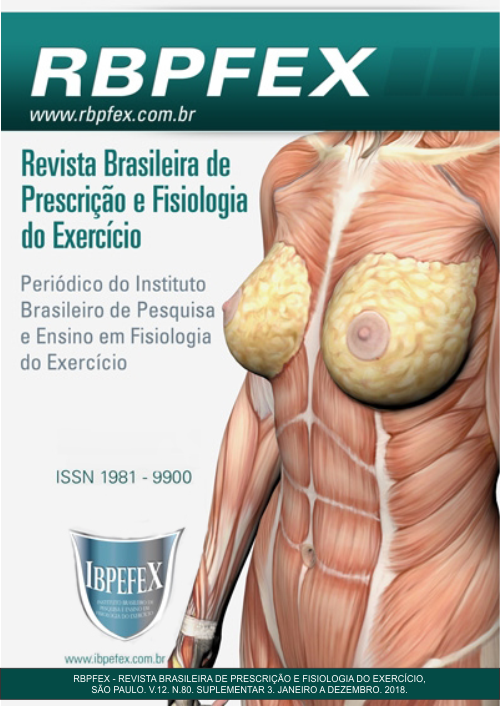Physical and performance characteristics of backs and forwards of the Rio Grande do Sul rugby team
Abstract
The aim of this study was to compare physical characteristics and performance parameters of Brazilian regional Rugby athletes, divided by player position. Total body mass, height, body mass index (BMI), yo-yo intermittent test level 1 (yo-yo test), vertical jump height, and bench press one repetition maximum (1RM) values were assessed in 15 forwards and 16 backs who formed the Rio Grande do Sul adult Rugby squad in 2010. Data were compared with the Student's T Test for independent measures, assuming α<0.05. Data show that forwards were heavier, stronger and displayed greater BMI compared to backs (p<0.05). The latter, however, performed better in the yo-yo intermittent recovery test 1 (p<0.05). The present results support position-specific \characteristics of backs and forwards according to their respective physiological demands, demonstrating that such differences are already apparent in competitive amateur athletes. The presented results may also provide reference values for coaches and regional athletes.
References
-Baker, D.; Nance, S. The relation between strength and power in professional rugby league players. J Strength Cond Res. Vol. 13. Núm. 3. p. 224-229. 1999.
-Bangsbo, J.; Iaia, F.M.; Krustrup, P. The yo-yo intermittent recovery test: a useful tool for evaluation of physicalperformance in intermittent sports. Sports Med. Vol. 38. Núm. 1. p. 37-51. 2008.
-Brewer, J.; Davis, J. Applied physiology of rugby league. Sports Med. Vol. 20. Núm. 3. p. 129-135. 1995.
-Cadore, E.L.; Pinheiro, E.; Izquierdo, M.; Correa, C.S.; Radaelli, R.; Martins, J.B.; e colaboradores. Neuromuscular, hormonal, and metabolic responses to different plyometric training volumes in rugby players. J Strength Cond Res. Vol. 27. Núm. 11. p. 3001-10. 2013.
-Cunniffe, B.; Proctor, W.; Baker, J.; Davies, B. An evaluation of the physiological demands of elite rugby union using global positioning system tracking software. J Strength Cond Res. Vol. 23. Núm. 4. p. 1195-1203. 2009.
-Deutsch, M.U.; Keaney, G.A.; Rehrer, N.J. Time-motion analysis of professional rugby union players during match-play. J Sports Sci. Vol. 25. Núm. 4 p. 461-472. 2007.
-Gabbett, T.; King, T.; Jenkins, D. Applied physiology of rugby league. Sports Med. Vol. 38. Núm. 2. p. 119-138. 2008.
-Gabbett, T.J. A comparison of physiological and anthropometric characteristics among playing positions in sub-elite rugby league players. J Sports Sci. Vol. 24. Núm. 12 p. 1273-1280. 2006.
-Hennessy, L.; Kilty, J. Relationship of the stretch-shortening cycle to sprint performance in trained female athletes. J Strength Cond Res. Vol. 15. Núm. 3. p. 326-331. 2001.
-King, T.; Jenkins, D.; Gabbett, T. A time-motion analysis of professional rugby league match-play. J Sports Sci. Vol. 27. Núm. 3. p. 213-219. 2009.
-Komi, P.V.; Bosco, C. Utilization of stored elastic energy in leg extensor muscles by men and woman. Med Sci Sports Exerc. Vol. 10. Núm. 4. p. 261-265. 1978.
-Lombardi, V.P. Beginning weight training: the safe and effective way Dubuque: W.C. Brown, 1989.
-Meir, R.; Newton, R.; Curtis, E.; Fardell, M.; Butler, B. Physical fitness qualities of professional rugby league football players: determination of positional differences. J Strength Cond Res. Vol. 15. Núm. 4. p. 450-458. 2001.
-Mezzaroba, P.V.; Trindade, C.D.F, Machado FA. Indicadores antropométricos e fisiológicos de uma amostra de atletas brasileiros de rugby. Rev Bras Cien Esporte. Vol. 35. Núm. 4. p. 1021-1033. 2013.
-Moir, G.; Button, C.; Glaister, M.; Stone, M.H. Influence of familiarization on the reliability of vertical jump and acceleration sprinting performance in physically active men. J Strength Cond Res. Vol. 18. Núm. 2. p. 276-280. 2004.
-Roberts, S.P.; Trewartha, G.; Higgitt, R.J.; El-Abd, J.; Stokes, K.A. The physical demands of elite English rugby union. J Sports Sci. Vol. 26. Núm. 8. p. 825-33. 2008.
-Sayers, S.P.; Harackiewicz, D.V.; Harman, E.A.; Frykman, P.N.; Rosenstein, M.T. Cross-validation of three jump power equations. Med Sci Sports Exerc. Vol. 31. Núm. 4. p. 572-577. 1999.
-Sedeaud, A.; Vidalin, H.; Tafflet, M.; Marc, A.; Toussaint, J.F. Rugby morphologies: “bigger and taller”, reflects an early directional selection. J Sports Med Phys Fitness. Vol. 53. Núm. 2. p. 185-91. 2013.
-Spamer, E.J.; Port, Y.D.L. Anthropometric, physical, motor, and game-specific profiles of elite U 16 and U 18 year-old south African schoolboy rugby players. Kinesiology. Vol. 38. Núm. 2. p.176-184. 2006.
-Tobin, D.P.; Delahunt, E. The acute effect of a plyometric stimulus on jump performance in professional rugby players. J Strength Cond Res. Vol. 28. Núm. 2. p. 367-372. 2014.
-Ugrinowitsch, C.; Barbanti, V.J. O ciclo de alongamento e encurtamento e a "performance" no salto vertical. Rev Bras Educ Fís Esporte. Vol. 12. Núm. 1. p. 85-94. 1998.
-Wisløff, U.; Castagna, C.; Helgerud, J.; Jones, R.J. Strong correlation of maximal squat strength with sprint performance and vertical jump height in elite soccer players. Br J Sports Med. Vol. 38. Núm. 3. p. 285-288. 2004.
Authors who publish in this journal agree to the following terms:
- Authors retain the copyright and grant the journal the right of first publication, with work simultaneously licensed under the Creative Commons Attribution License BY-NC which allows the sharing of the work with acknowledgment of the authorship of the work and initial publication in this journal.
- Authors are authorized to enter into additional contracts separately for non-exclusive distribution of the version of the work published in this journal (eg, publishing in institutional repository or book chapter), with acknowledgment of authorship and initial publication in this journal.
- Authors are allowed and encouraged to post and distribute their work online (eg, in institutional repositories or on their personal page) at any point before or during the editorial process, as this can bring about productive change as well as increase impact and impact. citation of published work (See The Effect of Free Access).






